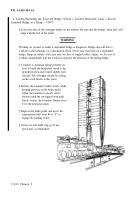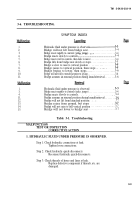TM-5-5420-203-14 - Page 160 of 298
TM 5-5420-203-14
f. Loading/Unloading a Scissored Bridge to/from a Lowbed or Flatbed Semitrailer using a crane
(20 ton capacity or higher)
- CONT
(1) Loading.
WARNING
The loading/unloading operation of the bridge is dangerous. If the hydraulic system fails
during the operation and the bridge breaks loose, property can be damaged and personnel
seriously hurt, if not killed. Essential personnel should always take extreme precautions
when working around the bridge and equipment, never place yourself under or in the path
of the bridge, if it were to fall. Non-essential personnel should stay clear of the
loading/unloading operation at all times, remaining at least 50 feet away. Always be
aware of what actions are going on around you at all time. Be sure to know your route of
escape in event of an emergency.
CAUTION
The crane operator should always use extreme caution when operating the crane, so as not
to impart damage to the bridge or semitrailer during a loading or unloading operation. If
in doubt about a certain procedure of the operation, the operators should stop the process
until they can resolve the problem. The bridge should always be handled cautiously and
safely.
NOTE
A lowbed semitrailer is preferred over the flatbed semitrailer for this operation because of
its lower trailer bed (3’3” vs. 4’4”) which results in a lower lift of the bridge for clearing
the trailer bed.
(a) Use a 20-ton or higher lifting capacity crane to lift the whole scissored bridge (Class 60 or
Class 70) onto a semitrailer (lowbed or flatbed).
(b)
Position the crane to one side and centered between the bridge (to be lifted) and the trailer (to
be loaded on). Stabilize the crane platform by jacking up the crane.
(c) The crane operator should use a standard 4-legged chain sling with lifting hooks. Length of
the legs should be approximately 20 feet long and each leg being of equal length. Prior to
lifting the bridge, the tie-rod ends should be chained together to prevent the bridge ends from
opening during the operation.
(d)
Attach the sling to the four lower lifting points (two nearest the center of the bridge and two
nearest the bridge ends), located along the outboard sides of the bridge. Always hook up to
the lower half of bridge. The upper half will merely rest on its lower half during the lift
operation. This lift method will lift the folded bridge straight upwards for loading onto a
semitrailer. The transport of this configuration is considered to be an “Oversized Wide Load”
and will require proper vehicle escort from point of origination to point of destination.
2-110 Change 2
Back to Top




















